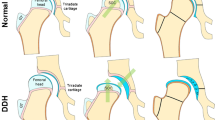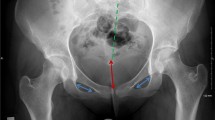Abstract
Establishing radiation-free imaging methods for the assessment of clavicular ossification in forensic age determination is desirable as it reduces radiation exposure in living individuals. For this purpose the stage of ossification of the right medial clavicular epiphysis was determined prospectively using sonography in 309 male and 307 female healthy volunteers. The classification of stages according to Schulz et al. was used for this purpose. Stage 2 was first noticed at the age of 14.4 years in males, and at the age of 14.1 years in females. Stage 3 was first achieved by males at the age of 17.6 years and by females at the age of 17.4 years. Stage 4 first occurred in males at the age of 19.3 years and at the age of 18.9 years in females. The mean age for stage 1 was 13.6 years. The mean age of stage 2 ranged between 17.3 and 17.6 years. For stage 3 the mean age varied from 20.7 to 21.2 years, and for stage 4 from 23.3 to 23.5 years. It was concluded that sonographically determined stage 4 clavicular ossification provides evidence for the completion of the nineteenth year of life in males and the eighteenth year of life in females. In order to increase the reliability of age determination using this method it is recommended that findings be recorded by at least two experienced independent examiners who then reach a consensus.





Similar content being viewed by others
References
Gunst K, Mesotten K, Carbonez A, Willems G. Third molar root development in relation to chronological age: a large sample sized retrospective study. Forensic Sci Int. 2003;136:52–7.
Olze A, Schmeling A, Taniguchi M, Maeda H, van Niekerk P, Wernecke K-D, Geserick G. Forensic age estimation in living subjects: the ethnic factor in wisdom tooth mineralization. Int J Legal Med. 2004;118:170–3.
Knell B, Ruhstaller P, Prieels F, Schmeling A. Dental age diagnostics by means of radiographical evaluation of the growth stages of lower wisdom teeth. Int J Legal Med. 2009;123:465–9.
Tisè M, Mazzarini L, Fabrizzi G, Ferrante L, Giorgetti R, Tagliabracci A. Applicability of Greulich and Pyle method for age assessment in forensic practice on an Italian sample. Int J Legal Med. 2011;125:411–6.
Schmeling A, Grundmann C, Fuhrmann A, Kaatsch HJ, Knell B, Ramsthaler F, Reisinger W, Riepert T, Ritz-Timme S, Rösing FW, Rötzscher K, Geserick G. Criteria for age estimation in living individuals. Int J Legal Med. 2008;122:457–60.
Schmeling A, Reisinger W, Wormanns D, Geserick G. Strahlenexposition bei Röntgenuntersuchungen zur forensischen Altersschätzung Lebender. Rechtsmed. 2000;10:135–7.
Ramsthaler F, Proschek P, Betz W, Verhoff MA. How reliable are the risk estimates for X-ray examinations in forensic age estimations? A safety update. Int J Legal Med. 2009;123:199–204.
Schmidt S, Mühler M, Schmeling A, Reisinger W, Schulz R. Magnetic resonance imaging of the clavicular ossification. Int J Legal Med. 2007;121:321–4.
Hillewig E, De Tobel J, Cuche O, Vandemaele P, Piette M, Verstraete K. Magnetic resonance imaging of the medial extremity of the clavicle in forensic bone age determination: a new four-minute approach. Eur Radiol. 2011;21:757–67.
Hillewig E, Degroote J, Van der Paelt T, Visscher A, Vandemaele P, Lutin B, D’Hooghe L, Vandriessche V, Piette M, Verstraete K. Magnetic resonance imaging of the sternal extremity of the clavicle in forensic age estimation: towards more sound age estimates. Int J Legal Med. 2012. doi:10.1007/s00414-012-0798-z.
Schulz R, Zwiesigk P, Schiborr M, Schmidt S, Schmeling A. Ultrasound studies on the time course of clavicular ossification. Int J Legal Med. 2008;122:163–7.
Quirmbach F, Ramsthaler F, Verhoff MA. Evaluation of the ossification of the medial clavicular epiphysis with a digital ultrasonic system to determine the age threshold of 21 years. Int J Legal Med. 2009;123:241–5.
Schmeling A, Geserick G, Reisinger W, Olze A. Age estimation. Forensic Sci Int. 2007;165:178–81.
Kreitner K-F, Schweden F, Schild HH, Riepert T, Nafe B. Die computertomographisch bestimmte Ausreifung der medialen Klavikulaepiphyse—eine additive Methode zur Altersbestimmung im Adoleszentenalter und in der dritten Lebensdekade? Rofo. 1997;166:481–6.
Kreitner K-F, Schweden FJ, Riepert T, Nafe B, Thelen M. Bone age determination based on the study of the medial extremity of the clavicle. Eur Radiol. 1998;8:1116–22.
Schmeling A, Schulz R, Reisinger W, Mühler M, Wernecke K-D, Geserick G. Studies on the time frame for ossification of medial clavicular epiphyseal cartilage in conventional radiography. Int J Legal Med. 2004;118:5–8.
Kellinghaus M, Schulz R, Vieth V, Schmidt S, Schmeling A. Forensic age estimation in living subjects based on the ossification status of the medial clavicular epiphysis as revealed by thin-slice multidetector computed tomography. Int J Legal Med. 2010;124:149–54.
Kellinghaus M, Schulz R, Vieth V, Schmidt S, Pfeiffer H, Schmeling A. Enhanced possibilities to make statements on the ossification status of the medial clavicular epiphysis using an amplified staging scheme in evaluating thin-slice CT scans. Int J Legal Med. 2010;124:321–5.
Schmeling A, Reisinger W, Loreck D, Vendura K, Markus W, Geserick G. Effects of ethnicity on skeletal maturation—consequences for forensic age estimations. Int J Legal Med. 2000;113:253–8.
Schmeling A, Schulz R, Danner B, Rösing FW. The impact of economic progress and modernization in medicine on the ossification of hand and wrist. Int J Legal Med. 2006;120:121–6.
Meijerman L, Maat GJ, Schulz R, Schmeling A. Variables affecting the probability of complete fusion of the medial clavicular epiphysis. Int J Legal Med. 2007;121:463–8.
Langley-Shirley N, Jantz RL. A Bayesian approach to age estimation in modern Americans from the clavicle. J Forensic Sci. 2010;55:571–83.
Acknowledgments
This work was supported by the fund “Innovative Medical Research” of the University of Münster Medical School (SC 1 2 07 18).
Author information
Authors and Affiliations
Corresponding author
Rights and permissions
About this article
Cite this article
Schulz, R., Schiborr, M., Pfeiffer, H. et al. Sonographic assessment of the ossification of the medial clavicular epiphysis in 616 individuals. Forensic Sci Med Pathol 9, 351–357 (2013). https://doi.org/10.1007/s12024-013-9440-8
Accepted:
Published:
Issue Date:
DOI: https://doi.org/10.1007/s12024-013-9440-8




